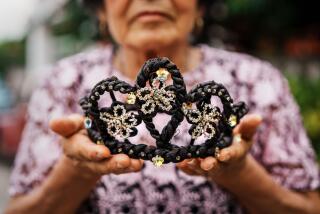Pageant Offers the Bottom Line in Beauty
- Share via
ABIDJAN, Ivory Coast — Here’s how Isabelle Zisson Sina and fellow contestants got ready for the big West Africa beauty pageant: Rested. Did their hair.
And ate with careful attention to their form, getting in competition shape: big bowls of porridge, meaty greens, fried plantains and the like.
Tipping the scales at 175 or 200 pounds, they ate all the while with compassion for those with other, scrawnier notions of beauty--those misguided Miss Universes, those Miss World-wannabes.
“One of your Misses, she follows a no-food diet,” says the 27-year-old Zisson Sina, a cushion of calm amid the backstage bustle of preparations for the Queen of Ivory Coast pageant.
“She’s skinny, her stomach is very flat here, she’s bony here,” says Zisson Sina, her hand fluttering up to her own rounded collarbones.
In Africa, “we eat well, to keep our shapes.”
If ever there was occasion to mull over what you think is beautiful, and why, Queen of Ivory Coast could be it.
Sponsors make clear they’re looking for that classic “guitar shape”--specifically, as the pageant rule book notes in detailed unblushing description of the ideal Queen, “a rounded, full-fleshed bottom, well-developed and in movement when the woman moves.” In past years, contestants competed with babies strapped to their backs.
Cabinet ministers presided at the title’s awarding on Saturday.
It’s not by chance the pageant is in West Africa, where thin is not yet entirely in. Fat farms flourish here--not for the shedding of pounds, but for the getting of them.
In some West African villages, self-esteem groups reportedly counsel skinny-and-worried-about-it adolescent girls, telling them it’s OK to be thin.
Secretly, though, the village girls know: Big is better.
Outside Africa, billions of dollars are spent by Americans and others to try to work off, diet off or suck up fat. For much of Africa, however, plump still means prosperity.
Thin represents everything you don’t want: poverty, AIDS and other diseases, misery and hunger.
“If we see a woman like one of those Misses, we think she doesn’t get enough to eat, or maybe she’s sick, or she’s mistreated by her husband,” says 33-year-old contestant Pauline Amlan, powdering her face backstage before a mirror held by a helper. Her figure rounds out her flowing fuchsia robe.
Some contestants are slighter, but none are skinny. The winner looked like she could have been among the slimmer of the 16 competitors--but with her body enveloped in swaying layers of violet robes and orange veils, it was impossible to tell for sure.
Queen of Ivory Coast was started in 1999 to reinforce Africans’ own traditions of beauty, says founder Poi Dokoui. “African women were getting a complex from the ads they see on TV,” Dokoui says.
Competitors wear traditional muu-muu-like robes known as boubous, head wraps and other traditional clothing.
Swimsuit competition--not a chance.
The audience perks up most, however, when two women entertainers come out to perform a traditional dance called the mapuka.
Dressed in demure evening gowns, the two women turn their backs to the audience, lean over and stick their hips out--launching into something that’s kind of like a belly dance, but not at all.
For hypnotizing minutes, things move or, rather, spin, using muscles that Miss New Jersey and Miss Rhode Island don’t even know they have.
Audience member Xavier Niadue and his friends, lounging up to now in a back row like passengers waiting for a plane, snap to as if their flight has just been called.
“When a woman does that, a guy goes crazy,” says Niadue, trying to answer a stranger’s questions without missing any onstage oscillating.
“With Americans, you think a woman should be like this,” Niadue says. He holds his hands out in front of his chest.
“But for Africans, we think the most important thing”--he reaches his hands back behind him to grab the most important thing--”is here.”
Back on stage, the action has turned back to Stately Walking.
The climax of each walk comes when each contestant hits the end of the runway and turns around. Slowly, sinuously, she gathers her robes about her at her hips as if it were to avoid tripping on the hem--but not really.
Voila. The audience applauds. Niadue and his friends fall deadly silent and stare hard.
The Queen contender sails slowly and serenely back up the runway. You almost can see the skinny Miss Worlds knocked flying from her path.
More to Read
Sign up for Essential California
The most important California stories and recommendations in your inbox every morning.
You may occasionally receive promotional content from the Los Angeles Times.










